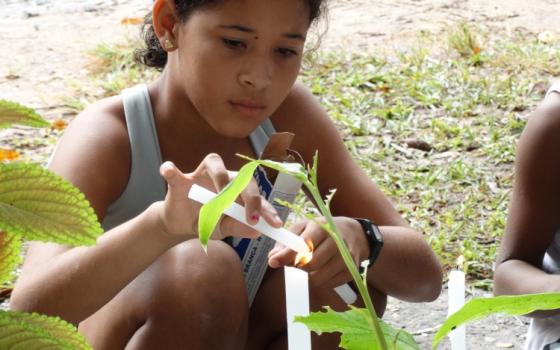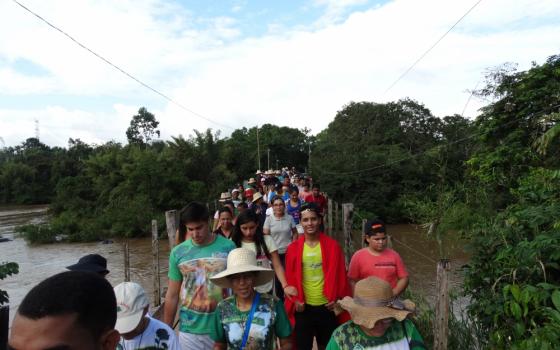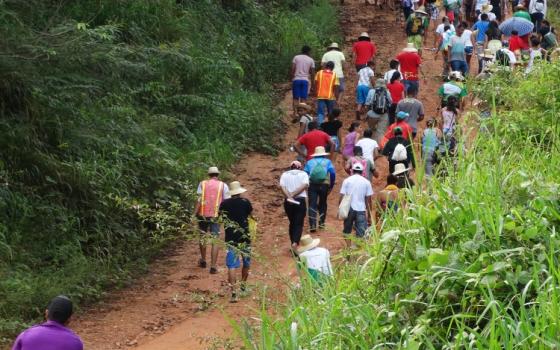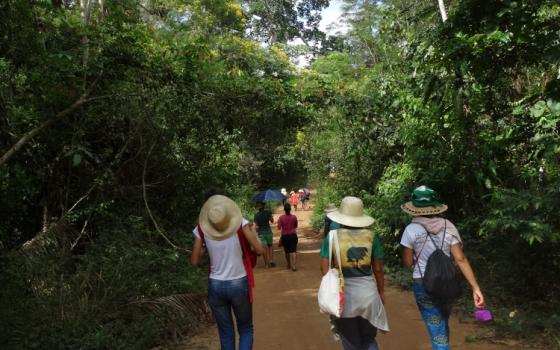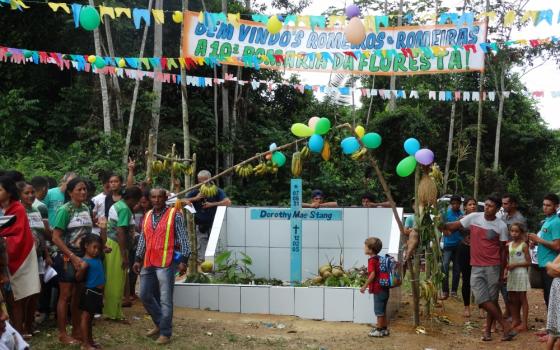Eleven years ago on February 12, 2005, Sr. Dorothy Stang, my sister in the congregation of the Sisters of Notre Dame de Namur, was murdered. She was gunned down by assassins hired by local ranchers. Dorothy's tireless work for the rights of the dispossessed and the protection of the Amazon rainforest stood in the way of the profits of logging and cattle ranching.
Since her murder, people gather each year in late July to remember Dorothy and to recommit to the work of justice and land reform by walking the Romaria da Floresta (Pilgrimage of the Forest), a 34-mile journey from Anapu, Pará, Brasil, where Dorothy is buried to the middle of a dirt road in the Boa Esperança Sustainable Development Project where she was murdered.
Last July I had the opportunity to go to Brazil and walk the same roads Sister Dorothy walked in her last days, to walk with the people for whom she lived and died. Over 200 people took part in this 10th pilgrimage: families and friends who knew Dorothy, youth groups, university students and professors, priests and sisters from many dioceses and religious congregations, journalists, environmentalists, young and old. As each day began, we gathered to sing and pray, to listen to Scripture, and to ponder questions that connected the ongoing struggle for justice to our lives of faith.
We walked together, up and down the hills that led us through mile after mile of land that only two decades ago was lush rain forest. I saw the remnants of trees in hastily cleared acres, burned down to make way for cattle. Because the soil can only sustain cattle grass for a few years, I saw miles of scrub vegetation. We rested each day between noon and three because the intensity of the sun in the areas that have been clear-cut is too much to bear.
Because I was slower than most, I often found myself at the back of the group, gazing at a beautiful image of faith painted over the hills by my fellow pilgrims, walking along the dirt road, singing songs of hope, remembering with each step that Earth is our common home and we need to do all we can to protect her (Laudato Si'). This walking meditation along that road from Anapu to Boa Esperança deepened and stretched my heart. St. Julie Billiart, our foundress, told the first Sisters of Notre Dame de Namur that their hearts needed to be as wide as the world. My heart became a bit wider on that road through the graced encounters with those with whom I walked.
Every journey changes us. Even after we've returned to the familiar external landscapes of our lives, our interior landscapes have been reshaped and do not go neatly back to the way they were. The Romaria da Floresta enfleshed the idea of journey for me. With my heart stretched and my feet aching, I felt my interior landscape shifting during the days of the journey, but I am realizing now that the greatest landscaping of my soul has been happening since I returned. As with so many journeys, seeds are scattered along the way that sprout and grow much later.
In these days since returning from Brazil I find myself wrestling with what looked to me like hope in the people with whom I walked on the Romaria. It creates a certain amount of dissonance within me to experience hope in the midst of continued suffering and injustice. My Portuguese is limited to a few basic phrases, so I did not have the privilege of deep conversations along the way. I could only observe what I saw and what I felt as I walked.
The hope of the people seemed to be expressed in the way they kept showing up in the struggle. Day after day, year after year, families continue to work the land using the sustainable methods Sister Dorothy taught them. Despite the threats made on their families by large cattle ranchers or loggers illegally cutting the majestic hardwoods, despite having their homes burned to the ground or their crops ruined by ranchers sowing cattle grass in their fields, these resilient farmers, often the first in their families to ever have land of their own, keep showing up. A living, embodied hope is the only way I can describe it.
What I witnessed was a hope that seemed to be deeply rooted in the community. Walking alongside different people over the three days of Romaria, I experienced hope as a communal virtue. It felt rooted in knowing one's self as a part of a people, a people with a past and a people with a future. Hope is a lived virtue, embodied as people continue to show up.
The hope I experienced during these days of pilgrimage was not neat and tidy. Rather it is life lived in the midst of a certain amount of chaos. It is not an optimism that everything is going to work out. It felt like a profound trust that, despite challenges and tragedies, this journey will continue. I felt the kind of hope Vaclav Havel described as "an orientation of the heart."
People will gather again in July to walk the Romaria da Floresta for an 11th time. They will sing the songs of the struggle, they will tell the stories of Sister Dorothy and many others who have been killed, and they will walk those same roads, embodying hope as they show up again to show that another world is possible when we know all people as brothers and sisters.
Dorothy once wrote, "Thank God St. Julie left us a strong heritage to be with the poor in their struggle for a more just existence." May our hearts continue to be landscaped ever wider and deeper so that we too can grow into a hopeful presence, showing up in the midst of the struggle, knowing ourselves as sister and brother to all people and all creation.
[Kristin Matthes, SNDdeN, works with young adults to provide ways to connect to the charism and mission of the Sisters of Notre Dame de Namur. She is a member of the Ohio Province Leadership Team and Vocation Ministry. She lives outside of Washington, D.C., in a community of Notre Dame Mission Volunteers and Sisters of Notre Dame de Namur.]
